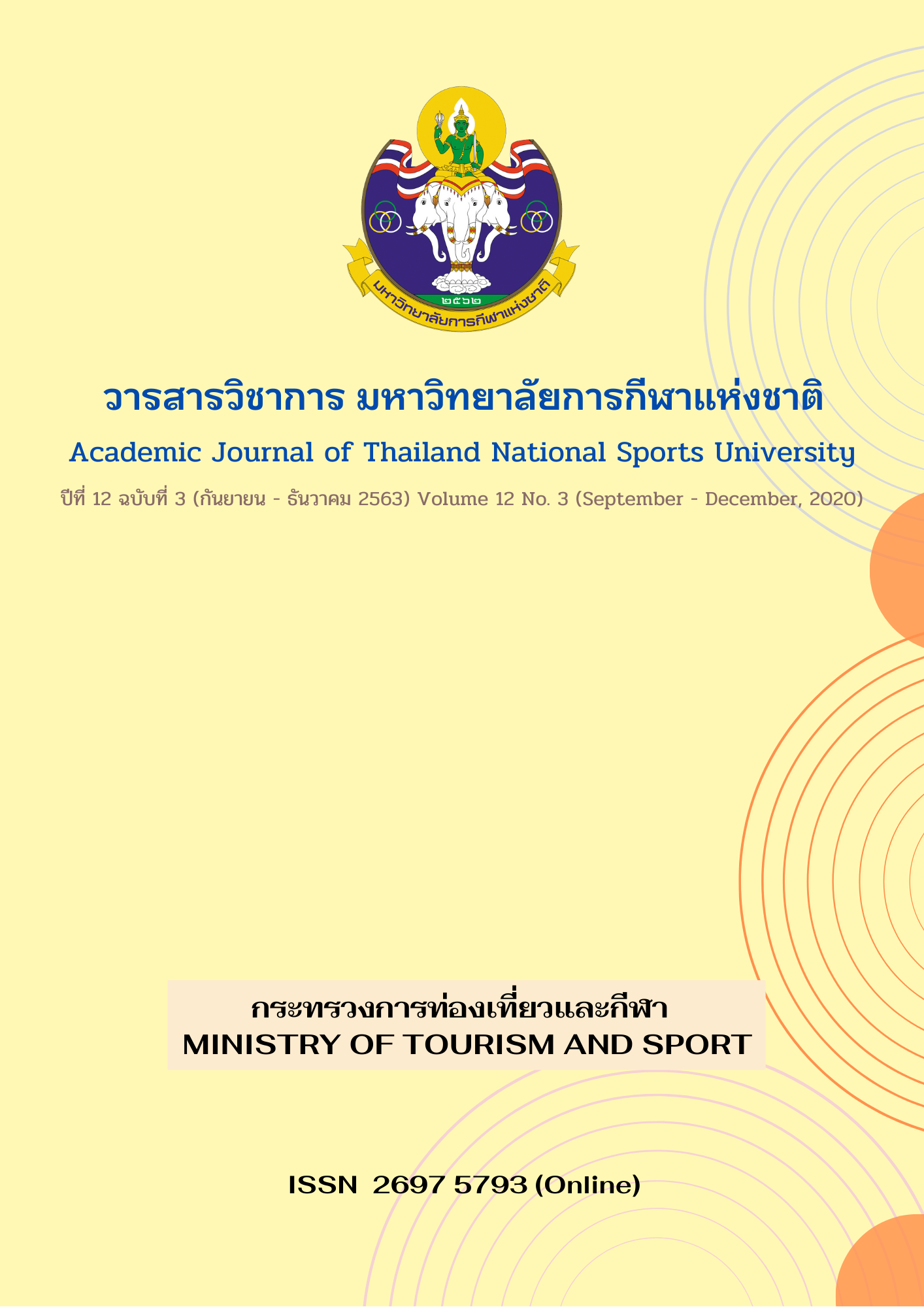PERFORMANCE AND COMPETITION ANALYSIS OF YOUTH TAEKWONDO ATHLETES
Main Article Content
Abstract
The objectives of this study was to analyze and compare the use of tactical and scoring characteristics variables during competition between the winners and the losers of young taekwondo athletes in the 32th Thailand National Youth Games. The subjects were 160 young taekwondo athletes (80 males and 80 females) who were qualified from quarter-final to the finalist of the ten weight categories. Two video cameras at 50 Hz were used to collect data. Kinovea software was used to analyze the use of tactical and scoring characteristics variables during competition including attacking techniques, attacking target and the point obtained format. Mean and standard deviation (S.D.) of the variables were computed and Independent t-test was conducted to evaluate any differences between winners and non-winners with a significance level of p < .05.
The results revealed that the average of attacking techniques between winners and non-winners was statistical significant with the highest level which was found in round kick in both males (winners: 46.05 + 7.79 points; non-winners: 40.40 + 7.79 points; p=0.02) and females (winners: 45.40 + 7.80 points, non-winners: 35.80 + 6.53 points; p=0.00) and the lowest level was found in turning kick for males (winners: 0.90 + 0.78 points, non-winners: 0.55 + 0.75 points; p=0.16) and back hook kick for females (winners: 0.35 + 0.58 points, non-winners : 0.15 + 0.36 points; p=0.20), respectively. The average of attacking target between winners and non-winners was statistical significant in both males and females. The average of attacking target at trunk (males; winners: 58.35 + 8.02 points, non-winners 51.10 + 6.88 points, p=0.04 and females; winners: 59.55 + 8.30 points, non-winners 48.10 + 6.73 point, p= 0.00) was higher than head guard (males; winners: 14.00 + 2.73 points, non-winners 6.88 + 3.06 points, p=0.00 and females; winners: 12.35 + 1.75 points, non-winners 9.80 + 2.53 points, p=0.01). The male winners scored offensive kicks (40.70 + 6.51 points) more often than defensive ones and the non-winners obtained more scores when using defensive kicks (37.45+ 5.31 points). In addition, the female winners scored offensive kicks (35.95 + 4.81 points) more often than defensive ones and the non-winners obtained more scores when using defensive kicks (32.90+ 6.38 points), respectively.
Consequently, an analysis and comparison of the use of tactical and scoring characteristics variables during competition of young taekwondo athletes in the Thailand National Youth Games revealed the significant tactical characteristics that affected the results of competition could be used to improve each individual training program.
Article Details
The published article is a copyright of the Academic Journal of Thailand National Sports University. The passage appeared in each article in this academic journal is a perspective of each author which is not related to the journal. Each author is required to be responsible for all components of his/her own article. If there are any mistakes, each author must be responsible for those mistakes on his/her own.
References
Casolino, E., Lupo, C., Cortis, C., Chiodo, S., Minganti, C., Capranica, L., & Tessitore, A. (2012). Technical and Tactical analysis of youth Taekwondo Performance. Journal of Strength and Conditioning Research, 26(6), 1489–1495.
Coral, F., Raul, L., Cristina, M., Jose., L. B. & Isaac., E. (2012). Match analysis in a University Taekwondo Championship. Journal of Advances in Physical Education, 2(1), 28-31.
Drazen, C., Sasa, K., & Mario, T. (2008). Differences between medal winners and nonwiner at the 2008 Olympic game taekwondo tournament. Journal of human movement, 12,(2), 165-170.
Kazemi, M., Waalen, J., Morgan, C., & White, A. R. (2006). A profile of Olympic taekwondo competitors. Journal of Sports Science & Medicine, 5(CSSI), 114-121.
Kinovea (2016). Kinovea video player for sport analysis. Retrieved from https://www.kinovea.org/
Kukkiwon. (2013). Foreigner Instructors course text book. Seoul. South Korea.
Lee, K. M. (2000). Taekwondo: Korean traditional martial arts. Philosophy & Culture.
Tze, C. L. et. al. (2001). Analysis of strategy used in taekwondo competition. Biomechanics Symposia 2001, University of San Francisco.
Victor G.F. Santos, Emerson, F., & Adriano E.L. (2011). Relationship between attack and skipping in taekwondo contests. Journal of Strength and Conditioning Research, 26(6), 1743-1751.
World Taekwondo. (2016). World taekwondo members. Retrieved from http://www.worldtaekwondo.org/about-wt/members/


